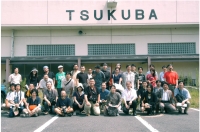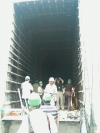 |
 |
|||||||||||||
|
|||||||||||||
|
|||||||||||||
|
On 18 and 19 August, a total of 38 leading Japanese creators, including science-fiction and fantasy writers, animation movie directors, comic artists, illustrators, and photographers, visited J-PARC (Japan Proton Accelerator Complex) in Tokai-village and KEK Tsukuba campus. This visit was coordinated by Junpei Fujimoto, a KEK scientist who is active in ILC outreach activities. “I noticed many Japanese science-fiction novels or animation movies have accelerators in their stories, so I wanted the creators to know and see real accelerators and the science behind them,” said Fujimoto. Yuji and Aya Kaida, who are members of Japan's science-fiction writers association, helped Fujimoto to arrange the visit. The first day of visit, the group gathered at Tokyo station and took a three-hour bus ride to Tokai village. On the way to J-PARC, Fujimoto talked about accelerators and particle physics in the bus. Group members asked many questions such as "What is a black hole?" "What is matter?" "Are accelerators safe?" Some wanted to know about KEK's organisational structure. Immediately after the group reached J-PARC, they took a group photo. In a control room, and neutrino specialist, Sho Tada of KEK, lectured on the neutrino beam line. In the lecture, he explained how neutrinos studies are necessary for fundamental physics. He quoted Nobel Prize winner Masatoshi Koshiba: “At first, the electron was not considered having any worth, but soon, the value of electron was admitted. I think that same thing will happen to the neutrino.” After the lecture, the group visited research buildings. The place which caught most attention was the "decay volume", where the neutrino beam will be generated. Tada explained only a few people have a chance to enter there, and the group members were eager to take pictures, showing their great curiosity. On the next day, 31 participants were divided into three groups. They toured the Belle detector, the Accelerator Test Facility (ATF), the Superconducting Test Facility (STF), and the Cockcroft-Walton Accelerator, the most popular machine among the group members. There are two colours of Cockcroft-Walton Accelerators at KEK, one in silver and the other in orange. The orange model is especially popular because it reminded them of "the Astroboy", a famous Japanese animation of the 1960's. After the facility tour, the group members and the scientists had a discussion. There were interesting questions which were very much like the one you could expect from science-fiction writers, such as: “In an animated space war movies, there are scenes like hard X-ray beams puncturing and destroying the battleships in space. I wonder what exactly happens if a powerful X-ray hits a large metal structure... Will it be that dramatic?” Scientists seemed to enjoy answering these questions. One scientist answered: “X-rays have low energy, at least gamma-rays would be needed and protons are better. But it would be difficult to control the proton beam in space because in the accelerators are controlled by magnets. For those protons to actually hit the target, we might need to ask our enemies to send back the signals of beam position monitors! ” After finishing the two-day tour, Fujimoto said “I was hoping this tour could inspire and let their imagination run wild, seeing the reality of science. I hope this will help their creation, and I look forward to seeing the accelerators in their works.” Fujimoto is planning to arrange another KEK tour like this again.. -- Naoyuki Shiba |
|||||||||||||
| © International Linear Collider |

